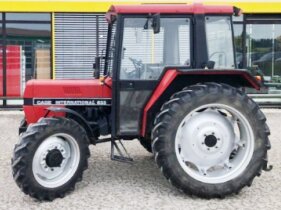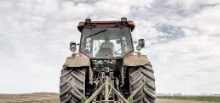________________________________________________________________________________________
| Home / Farm Tractors / Case IH Tractors / Case IH 633 |
Case IH 633 Troubleshooting
 The
Case IH 633 utility tractor was manufactured between 1975 and 1978. The Case IH
633 tractor is powered by 179 cu.in (2.9 L) Case D179 3-cylinder direct
injection liquid-cooled diesel engine with a rated power of 52 hp (38.8 kW).
The
Case IH 633 utility tractor was manufactured between 1975 and 1978. The Case IH
633 tractor is powered by 179 cu.in (2.9 L) Case D179 3-cylinder direct
injection liquid-cooled diesel engine with a rated power of 52 hp (38.8 kW).
The Case IH 633 is fitted with a 2 types of transmission. Type 1: Synchromesh transmission with 8 forward and 4 reverse gears. Type 2: IH Synchron 2-speed powershift transmission with 16 forward and 8 reverse gears. The maximum travel speed (forward/reverse): 15.3 mph (24.6 kph) and 8.9 mph (14.3 kph).
The open center hydraulic system has a gear pump with a rated capacity of 8.6 gpm (32.6 lpm). The hydraulic system pressure is 172 bar (2500 psi). The tractor is equipped with a mechanical or hydrostatic steering, hydraulic wet disc brakes, 6.50-16 (2WD) or 10.5-20 (4WD) front tyres, and 12.4/11-36 (2WD) or 16.9/14-28 (4WD) rear tyres. The wheelbase is 81.5" (2070 mm) for 2-wheel drive models and 80.2" (2030 mm) for 4-wheel drive models.
| Diesel Engine Troubleshooting |
| Engine difficult to start or doesn't start |
Air in the fuel system - Air bleeding.
Fuel filter plugging - Clean the filter or install new filter element.
Dirty or faulty injection nozzles - Clean or replace injection nozzles.
Water or dirt in fuel system - Drain, flush, and service the system.
The valve clearance is not adjusted - Check and adjust.
Fuel injection pump is defective - Repair or change injection pump.
| Engine starts but then stops |
Dirty air filter - Replace air filter element.
Fuel filter plugged - Filter maintenance required.
Fuel injection pump has loose connections - Tighten the connections.
Defective fuel injectors - Replace or clean fuel injectors.
Fuel injection pump is not working correctly - Replace or rebuild injection pump.
| Engine shuts off suddenly during operation |
Engine not warmed up - Normalize the temperature by warming up the engine.
Fuel filter element is dirty - Filter maintenance required.
Air in the fuel pipes - Bleed the fuel pipes.
Fuel injection nozzles are clogged or faulty - Test injection nozzles and change if necessary.
Fuel injection pump timing is wrong - Set up as recommended.
| Engine stops while idling |
Low idle speed setting is incorrect - Adjust low idling as recommended.
Damaged fuel injection pump - Replace injection pump or repair it.
Clogged or defective injectors - Replace or clean fuel injectors.
Incorrect valve clearance - Correct valve clearance.
| Engine power is insufficient |
Clogged air filter - Change air filter element.
Dirty or damaged injection nozzles - Check injection nozzles and replace if required.
Uneven fuel injection pressure - Correct the pressure settings.
The valve clearance is incorrect - Adjust valve clearance.
Low idle speed setting is incorrect - Correct low idle settings.
Dirt in the fuel hoses or lines - Clean fuel hoses and lines.
Cylinder head gasket is defective - Install a new gasket.
Piston rings are leaking or defective - Replace the piston rings as required.
| Engine overheated |
Insufficient coolant - Add coolant and check the components of cooling system.
Engine oil insufficient - Fill up the engine oil.
Dirty radiator fins or defective radiator cap - Replace cap or clean radiator.
Fan belt slipping or worn - Change the fan belt.
Engine overloaded - Load reducing required.
| Low oil pressure |
Low oil level - Fill up the engine oil.
Oil filter element clogged - Change or clean engine oil filter element.
Oil grade or viscosity is wrong - Use oil of proper viscosity.
Crankshaft bearing has incorrect oil clearance - Replace bearings.
Oil pump is defective - Remove and inspect oil pump.
| Engine noises or knocks |
Low engine oil level - Check oil level and add oil as required.
Engine not warmed up - Normalize the temperature by warming up the engine.
Wrong setting of fuel injection pump timing - Adjust according to specifications.
Improperly adjusted low idle speed - Adjust low idling as recommended.
Defective fuel injectors - Test and replace fuel injectors if necessary.
Connecting rod is misaligned or worn - Replace or align connecting rod.
Pistons are broken or worn - Install new pistons.
| Transmission Troubleshooting |
| Insufficient transmission fluid pressure |
Transmission oil level is low - Fill up the transmission oil.
Clogged transmission fluid filter (if equipped) - Service or replace the transmission fluid filter.
Relief valve is damaged - Install a new relief valve.
| Transmission noises |
Transmission oil insufficient - Add oil to the transmission housing.
Transmission oil is contaminated - Change the oil.
Gears are defective or backlash is improper - Replace gears or adjust backlash correctly.
Bearings are cracked or worn - Change the bearings.
Shift forks are worn or bent - Change defective shift forks.
Shaft splines are worn or damaged - Shaft need to be changed.
| Difficult to shift gears |
Gear shift linkage is rusty or worn - Install a new gear shift linkage.
Shift forks are worn or bent - Replace defective shift forks.
Worn out parts of the gearshift mechanism - Replace worn parts.
Improperly adjusted or worn clutch - Adjust clutch or replace if required.
| Transmission fluid leakage |
Too much oil in transmission - Drain the excess oil.
Damaged gaskets or seals - Gaskets or seal replacement required.
| Hydraulics Troubleshooting |
| Hydraulic oil pressure too low |
Hydraulic oil is insufficient - Check and refill the hydraulic oil.
Clogged hydraulic fluid filter - Service the hydraulic filter or change if required.
Hydraulic pump is faulty - Change or repair hydraulic fluid pump.
Incorrect adjusted hydraulic control valve - Adjust correctly.
Defective hydraulic cylinder - Repair or install a new hydraulic cylinder.
Leaking hydraulic lines - Check the hydraulic system and fix leaks.
| Excessive hydraulic system heat |
Main relief valve is faulty - Relief valve replacement required.
Wrong hydraulic fluid type - Pour the proper type of fluid.
Hydraulic oil contamination - Change the oil.
Air in hydraulic lines - Bleed hydraulic lines.
| 3-point hitch won't lift or lifts slowly |
Excessive hitch loading - Load needs to be reduced.
Insufficient hydraulic fluid - Add fluid as required.
Clogged hydraulic fluid filter - Change the hydraulic filter element or service if required.
Faulty hydraulic pump - Change or repair hydraulic fluid pump.
Defective main relief valve - Relief valve must be changed.
Faulty hydraulic spool valve - Repair or change the valve.
Hydraulic cylinder is broken - Repair or change hydraulic cylinder.
Suction line is disconnected or broken - Replace or connect correctly.
| 3-point hitch won't lower or lowers slowly |
Hydraulic control valve block is set improperly - Set properly.
Hydraulic cylinder failure - Repair or replace hydraulic cylinder.
The three-point hitch is not adjusted - Need to make adjustments.
Hitch rock shaft is worn Change the shaft.
| Hitch lowering or lifting is jerky |
Air in the hydraulic system - Air bleeding.
Dirty hydraulic fluid - The fluid must be changed.
Hydraulic pump failure - Repair or replace hydraulic fluid pump.
Faulty hydraulic spool valve - Repair or change the valve.
Hydraulic cylinder failure - Repair or install a new hydraulic cylinder.
| Steering Troubleshooting |
| Heavy steering |
Incorrectly mounted or defective steering column - Mount the steering column correctly or replace it.
Air in the hydraulic steering system - Bleed the steering system.
Incorrect toe-in - Adjust toe-in wheels.
Front tires wear unevenly - Change the tires.
Hydraulic steering pump is defective - Repair or replace steering pump.
Pump flow control valve is damaged or stuck - Clean or replace control valve.
Insufficient steering oil - Need to add steering oil.
| Excessive free play of steering wheel |
Steering column shaft or coupling is worn out - Replace defective component.
Steering pump malfunction - Replace or repair steering pump.
Steering linkage assembly is worn or loose - Inspect and replace as required.
| Tractor is pulling to right or left |
Front tires wear unevenly - Change the tires.
Not adjusted toe-in - Adjust toe-in properly.
Steering linkage components are loose or worn - Inspect and change as required.
Defective or improperly adjusted front wheel bearings - Adjust correctly or install new bearings.
| Electrical Troubleshooting |
| Battery does not charge |
Loose or corroded cable connections - Clean or tighten wiring connections.
Electrical terminal connectors are faulty - Install new terminal connectors.
Bad cell in battery - Use a new battery.
Loose or defective belt - Adjust belt tension or change the belt.
| Starter cranks slowly |
Battery power is low - Recharge the battery.
Battery is draining quickly - Service charging system or install new battery.
Disconnected wires or corroded battery terminals - Check cables and clean or change terminals.
| Starter is not working |
Battery is low or faulty - Need to charge or replace the battery.
Battery cables are disconnected or improperly connected - Inspect cables and connect properly.
Low battery output - Battery is drained, charge it.
Faulty starter motor - Starter should be changed.
________________________________________________________________________________________
________________________________________________________________________________________
| Farm Tractors Technical Specifications |
